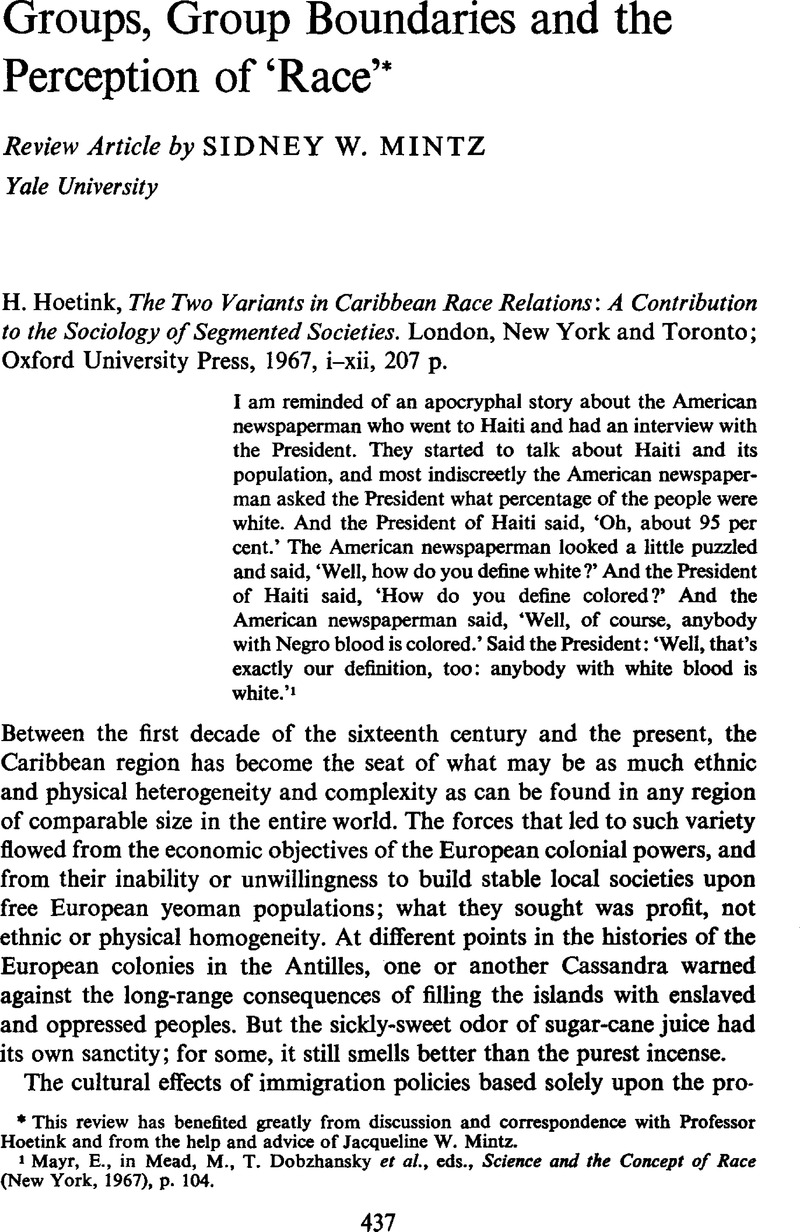Published online by Cambridge University Press: 03 June 2009

1 Mayr, E., in Mead, M., Dobzhansky, T. et ah, eds., Science and the Concept of Race (New York, 1967), p. 104.Google Scholar
2 Curtin, P., The Atlantic Slave Trade (Madison, 1969). Curtin estimates that nearly nine and one-half million African slaves reached the New World alive; the majority were transported to Brazil and the Caribbean region. Curtin's total estimate for the Caribbean islands alone, excluding all nearby mainland areas, comes to 2,602,000, or approximately 28 percent of the total.Google Scholar
3 Lamming, G., The Pleasures of Exile (London, 1960), p. 37.Google Scholar
4 Curtin, P., Two Jamaicas (Cambridge, 1955).Google ScholarMintz, S., review of Curtin, P.. Two Jamaicas, Revista Interamericana de Bibliografia, Vol. VI, No. 1, 1956, 56–8.Google Scholar
5 Hawaii, whose history shares much with that of the Antilles, affords us an illuminating instance of the process. The successful importation of Puerto Rican plantation laborers to solve a labor shortage was described in the following terms (United States Department of Labor, 1903, p. 709):
From the planters’ point of view an important result of the Puerto Rican immigration was the moral effect that their arrival had upon the Japanese. The latter had begun to fancy that with the enforcement of the Federal Chinese exclusion and contract laws after annexation they were complete masters of the labor situation in Hawaii. They formed temporary combinations for the purpose of striking at critical periods of the planting and grinding season, and in this way had succeeded in forcing up wages. This is sufficiently shown by the rise in the average wage of field hands from 60 to 75 cents a day, or an increase of over 25 per cent during the year ending June 30,1901—the first twelve months following annexation. The regular arrival of monthly expeditions of Puerto Rican laboring people throughout an entire year largely disabused them of this sense of monopoly and made them much more reasonable in their relations with their employers.
There is no amusement to be had from the discovery that the writer is the Commissioner of Labor. The consequences of this manipulation of Puerto Rican migrants for their later acculturation in Hawaii were very serious (cf. Mintz, 1955). United States Department of Labor, Report of the Commissioner of Labor on Hawaii (Washington, 1903).Google ScholarMintz, S., ‘Puerto Rican migration: a threefold comparison’. Social and Economic Studies, 4, 1955.Google Scholar
6 Mintz, S., review of Smith, M. G., A Framework for Caribbean Studies, Boletin Bibliogrdfico de Antropologla Americana, Vol. VIII, No. 1, 1957, 189–94.Google Scholar
7 Harris, M. ‘Referential ambiguity in the calculus of Brazilian racial identity’, Whitten, N. and Szwed, J., eds., Afro-American Anthropology (New York, 1970).Google Scholar
8 Leyburn, J.The Haitian People (New Haven, 1966), p. 17.Google Scholar
9 Ibid., p. 18.
10 Mintz, S., review of Klein, H., Slavery in the Americas, American Sociological Review, 33, 1969.Google Scholar
11 Martinez-Alier, V. ‘Color, clase y matrimonio en Cuba en el siglo XIX’. Revista de la Biblioteca National Josi Marti, Año 59, 1968.Google Scholar
12 Knight, F.Slave Society in Cuba during the Nineteenth Century (Madison, 1970), pp. 179–91.Google Scholar